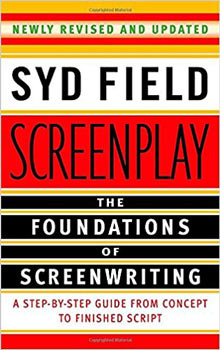This post contains affiliate links that earn commissions from qualifying purchases.
Studying the craft of writing from a variety of angles will benefit any writer. If you write short stories, you’ll learn something from studying a little poetry. If you write poetry, you can learn something useful from playwrights. And if you’re a novelist, you can pick up some great tips from the craft of screenwriting.
Screenplay by Syd Field is a principal book on screenwriting. I first read it back in college, and the instructor was very clear: anyone who wants to write and sell a screenplay must read this book.
According to Field, “Everyone wants to write a screenplay.” I know he’s speaking figuratively, but I have no desire to write a screenplay. I am passionate about the craft of writing, so I read books about a variety of forms and genres, and I always learn something from them that I can apply to my own work in fiction, nonfiction, and poetry.
There are a few chapters in this book that pertain exclusively to screenwriters, but the bulk of the book focuses on storytelling, and it’s packed with wisdom that will benefit fiction writers of all forms.
A Book for Storytellers
In my experience, it’s hard to find good books on storytelling. Many of them are written by authors who insist on a particular formula or process that they invented for themselves, and they assert that this is the only way to write fiction.
This is important: there’s no right or wrong way to write a novel. There are best practices that you can follow, which will increase your chances of success, but there’s definitely no single process that will lead to success.
However, there are some truths that can be applied to most fiction projects. For example, every story has a beginning, middle, and end. Every story is formed from the core building blocks of character, plot, setting, and theme. Every story contains action and dialogue. Screenplay addresses all of these aspects of storytelling in ways that are applicable to all storytellers.
Here are a few of my favorite tidbits of wisdom from the book:
- “All drama is conflict. Without conflict, you have no action; without action you have no character; without character, you have no story.” (p 25)
- “The incidents you create for your characters are the best ways to illuminate who they are — that is, reveal their true nature, their essential character.” (p. 44)
- “With your writing schedule set up, you can get down to work; and one fine day you will sit down to write. What’s the first thing that’s going to happen? Resistance, that’s what.” (p. 243)
Field talks about physical and emotional action and the need for conflict, struggle, and obstacles both externally and within the characters’ emotional and mental landscapes.
Going beyond story structure, Field offers a host of tips on how to write, and he is clear in stating that the process he’s proposing works well for him and he believes it will work well for others, but he also notes that each writer must find their own best process, which is a sign of a good writing teacher.
Two of my favorite chapters, with titles that are self-explanatory, were “Endings and Beginnings” and “Setting Up the Story.” You’d expect a chapter called “The Scene” to be film-centric in a screenwriting book, but this one is more about story and what a scene must accomplish to move the story forward or reveal essential information about the characters.
Speaking of characters — there are not one or two — but three chapters on character, including “Creation of a Character,” “Building a Character,” and “Story and Character.” Characters are the heart of any story, whether it’s on the screen or on the page, and these chapters are stuffed with good advice on crafting characters.
Essential for Screenwriters
The book is called Screenplay, so of course it includes chapters that are exclusively the domain of screenwriting. I found these chapters interesting because they showed how the narrative of a screenplay is written differently from a novel. I already knew that you can do things in filmed stories that can’t be done in written narratives — and vice versa. Field makes it very clear: movies are stories told in pictures. Then he shows how a screenplay should use words to describe the pictures that will tell the story onscreen.
Hollywood won’t even look at your script if it doesn’t follow proper form, and the book provides an introduction to the form along with recommendations for screenwriting software.
A chapter on adaptation is particularly useful and should probably be read by any author who someday hopes to see their novel on the big screen.
Finally, one of the most interesting and practical chapters in the book is called “After It’s Written,” which gives the lowdown on how to get a script seen and sold, addressing the steps one should take to work through the Hollywood system, including alternatives that are available to help first-timers actually sell a script.
 Screenplays Are Stories
Screenplays Are Stories
Any storyteller will glean wisdom from Screenplay, but some parts are strictly for screenwriters. I would highly recommend this book to anyone who’s interested in storytelling, especially if they have any interest in writing for film. Get your copy today!




You said IF you write short stories you benefit from studying poetry. ANY writer will benefit from studying poetry. There is something to knowing how stressed and unstressed syllables fit in your sentences. Poets also use sensory words that make sentences stronger and more fun to read. You have to use all the building blocks to write strong stories no matter if they are for children or novels or whatever. Learn about poetry.
Yes, well I think it’s implied pretty clearly that studying poetry benefits all writers. The whole point of the introduction is that studying across forms and genres will be beneficial, even for writers who are focused on one form or genre.
I have owned a copy of this book since the 1980’s (no doubt an earlier version!) and I have found it enormously helpful in understanding story and learning how to craft it on the page. The key concepts that Field uncovers are as applicable to novel form as to playwrighting–and poetry, I suspect.
I agree. I don’t often read books twice, especially writing resources. But it was a pleasure to revisit this one!